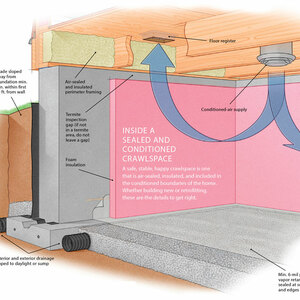Attic insulation- sealed or vented
I have a Craftsman home built in the early 50’s with little to no insulation in the attic. There is a gable vent but that is all. No soffit vents or ridge vents. I installed an attic fan to the only vent to try to help but there is no cross ventilation. If I add blown in fiberglass I will lose the storage space, which I would hate. I recieved a quote from an insulation contractor and he advised me to spray foam (open cell) to the underside of roof and seal off vent to have an unvented attic that he said would stay within ten degrees of the temperature inside my home and that way I could keep my storage and store items that normally would not be stored in an attic because of the heat. I live in Georgia so winter is not really a concern. I have read all the articles I can find and watch all the DIY shows to try to be enlightened with more tips but I’m stumped. The quote was for $3800 for open celled foam and $700 for blown in. What do you think?


















Replies
Accomplish
I am not too sure on what you want to accomplish from the above post.
What is your Goal? Improve insulation, increase storage space, increase ventilation, condition storage space, or all of aforementioned.
Using the spray foam straight against the roof changes things to a quasi-hot roof design. (True hot roofs do not have breaks in the insulation and have a complete seal) Although this might be excessive for your needs it is a simple long term solution. Additionally it might be worth looking at getting the work done directly by a spray foam company instead of a contractor to save a few dollars.
The other consideration is the joists in this area, typically ceiling joists are not the same width as floor joists because they do not need the same dead or live load capacities as floors do. i.e. floors are usually 2x8+ and ceilings are 2x4+ dependent on spans. For light live and dead loads ceiling joists are typically fine, but if you are looking at making this a regularly accessed area storing larger loads it may be good to check how wide the joist that will make up your new floor are and possibly ask an engineer about the change.
Overall if it is just some extra light storage space you’re after, and if the joists are thick enough. It might be fine just using it as is with a sheet of plywood thrown down. But it always wise to get an opinion from a licensed professional to make sure you’re not doing something dangerous or illegal.
So as I see it, if your joists are good then
Spray foam = long-term, warm area, add extra ventilation if wanted
Blown in= medium term solution, cold slightly smaller area, add extra ventilation if wanted
I would go Spray foam if you plan on using the area a lot, and blown in if you’re just throwing the odd Christmas tree in there as needed.
Goal
My goal is to keep the storage I have now but add insulation to lower my electric bill during the long GA summers. Because I don't plan to stay in this house long term I know that the logical answer is to blow insulation into my attic. At the same time I'm trying to justify paying for the spray foam instead.
I am just trying to find some answers to make my decison. Some say that a house has to breathe and attics need to be vented. Should I invest in ridge vent?
Others say that a house doesn't need to "breathe." Is it ok to seal off my attic? In GA we have mildew problems, will this be an issue?
Would spray foaming the attic be a selling point on down the road?
As far as support in the attic, the joists are real 2x4's and I do have plywood down in the area around the entrance. Nothing really heavy, just holiday stuff in plastic bins. But if I went with the blown in insulation I would have to make a platform for storage. Plus build an insulated panel box over the ladder and then there's the mess that blown in fiberglass makes if you change out a light fixture or have a leak, etc.
Thanks for your reply.
Control and foam
First off, all houses need to have at least one form of air exchange or another, otherwise they wouldn't be habitable. From what I understand when a person says a house needs to "breathe" or not is a reference to Active or Passive air exchange. (Passive is systems like soffit vents, ridge vents etc.) (Active is ventilator units, attic fans, HRV's ERV's, etc.)
There is a lot of material regarding these concepts and a HVAC specialist in your area might know what the ideal setup would be. Although an active system is much more costly its ability to be controlled may be something that could benefit you.
Though both systems can be used with either type of insulation, Blown In works better with passive systems (i.e. ridge vents) and Spray Foam with active systems. Some info on attics insulation and spray foam can be found here Page 2 has some interesting info on roof benefits.
More insulation installed properly always adds value to a home, not to mention reducing other costs.
When you Mentioned real 2x4's that got me thinking about my parents’ home which was built in the 50's as well, they have rough sawn redwood 2x4's, and though they are stronger than normal spf lumber, they are still not meant to be walked on frequently if they cover large spans. The plywood helps distribute the weight and should be fine for the light storage you have planned.
I think spray foam might be the best solution for you but I would ask a HVAC specialist if active venting is needed just in case.
Good Luck
Thanks reinerfox!
If you're trying to cool the space below, and not make the attic habitable, the "all of the above" solution would be the most ideal -- Spray foam the roof, install insulation in the attic "floor", AND improve ventilation of the attic area.
(This, of course, will not make the attic itself "cool", but will make it substantially cooler. But more significantly, the cooling load for the rest of the house will be reduced.)
Thanks
Appreciate the opinion.
The costs sound about right - you have to decide if the storage is worth it to you. When I was a realtor it was commonly accepted that such improvements didn't contribute to the appraised value of the house, even though it's an improvement these things just don't make that much of a difference so you most likely won't get your money back.
There's a little confusion about using foam and venting. If the roof is insulated so the attic is within the insulation envelope then the attic doesn't need to be vented and honestly I can't think of any benefit of doing so.
As for your "real 2x4's" that's not enough to support the weight of anything other than the ceiling. If you walk on them, let alone store anything heavy you'll be creating ceiling sag and cracks - the correct way to do it is install additional joists sized for the amount of weight you have up there.
Cheap attic insulation by blowing in cel or fiberglass and attic storage just doesn't work. Blow in r60 celulos, get rid of your attic storage and you'll be shocked at what a difference it makes not only in the drop in cooling costs, but overall comfort of the home year round. Insulation is the only expenditure in your house that will completely pay for itself over time.
Beer was created so carpenters wouldn't rule the world.
Thanks for the advice.
Bravo for answering!